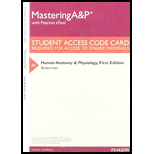
Concept explainers
Which of the following is not a basic function shared by all cells?
a. Cell
b. Communication
c. Cell reproduction
d. Cell movement
e. Transport of substances through the cell
Introduction:
In a living organism, the basic units are cells. Based on the estimation, there are almost 10 trillion cells in a human body that work together to regulate homeostasis. Being the basic unit, the cells form a group, which can perform a specific role in the human body. The functions performed by the cells differ based on the group of cells.
Answer to Problem 1CYR
Correct answer:
Cell movement is not the basic function.
Explanation of Solution
Justification/Explanation for the correct answer:
Option (d) is cell movement. This is not a basic function of the cell. Cell movement is also called cell migration. Cell migration often results in the altering of cell morphology. Cell movement is often associated with microorganismsthat have cilia and flagella as their locomotory appendage. Not all cells can exhibit movement. Hence, option (d) is correct.
Explanation for the incorrect answers:
Option (a) is cell metabolism. Cell metabolism is a basic function of the cells. To maintain life, a cell must undergo various chemical reactions. These chemical reactions are called cell metabolism. Catabolism, anabolism, and oxidation–reduction reactions are various types of cell metabolism. So, it is an incorrect option.
Option (b) is communication. Cell communication is an important function of the cells. Not only the cell has to communicate with itself, but it also has to communicate with its surrounding. The communication within the cell and with its surrounding occur bymeans of electrical and chemical stimuli. So, it is an incorrect option.
Option (c) is cell reproduction. The cell reproduction is the basic function performed by the cell in a living system. The cells undergo cell division, which is the means of cell reproduction in the living organism. Cell division aids in development, growth, and regeneration. So, it is an incorrect option.
Option (e) is transport of a substance through the cell. The cells in our body are capable of producing compounds and transport them to the surrounding environment. Cells can also secrete the compound themselves and transport it to other cells. This is the basic function of z cell. So, it is an incorrect option.
Hence, options (a), (b), (c), and (e) are incorrect.
Hence, it can be concluded that cell movement is not the basic function. Even though some cells exhibit migration, not all the cells are capable of cell movement. Cell metabolism, communication, cell reproduction, and transport of a substance through the cells are the basic functions performed by the cell.
Want to see more full solutions like this?
Chapter 3 Solutions
Mastering A&p With Pearson Etext -- Valuepack Access Card -- For Human Anatomy & Physiology
- The plasma membrane __________. a. surrounds the cytoplasm b. separates the nucleus from the cytoplasm c. separates the cell interior from the environment d. both a and carrow_forwardAll cells have all of the following except a. plasma membrane. b. genetic material. c. cytoplasm. d. cell wall.arrow_forwardWhich of the following explains why a cell's size is limited? a The cell membrane increases too fast for the cytoplasm to keep up with its reactions. b The cell membrane becomes rigid. c The cell membrane cannot supply enough substances to support organelles in the center. d The cell membrane is too large to allow for transport.arrow_forward
- A cell that contains a lot of mitochondria is most likely ___. Select one: a. producing a lot of ribosomes b. using a lot of energy c. using a lot of phospholipids d. producing a lot of proteinarrow_forwardWhich of the following cellular features are common to all classes of cells? A. Presence of genetic material B. Cell division C. Photosynthesis D. Plasma membrane A, B, D only B, C, D only A, B, C only A, B. C. Darrow_forwardWhich of the following statements is NOT true about the cell theory? a. All cells arise spontaneously. b. All cells arise from preexisting cells. c. All living organisms are made up of cells. d. Cell is the basic unit of life.arrow_forward
- Without a properly functioning membrane, a cell would (a) not be able to give instructions to its organelles (b) not be able to hold a rigid shape (c) not be able to absorb sunlight (d) not be able to remove waste materialsarrow_forwardWhich of the following BEST represents the function of DNA in a cell? A) to provide structure and support to the cell B) to store genetic information C) to speed up the rate of reactions in the cell D) to digest macronutrients in the cell’s cytoplasmarrow_forwardA selectively permeable A. allows some substance to move across the membrane, but not others B. allows unlimited movement of materials into or out of the cell C. allows substances to enter, but prevent any substances from leaving the cell D. allows only helpful materials to cross the the cell membrane into the cellarrow_forward
- Which of the following is NOT a major part of the cell? a. cell membrane b. cell wall c. cytoplasm d. nucleusarrow_forwardThe main arena of various types of activities of a cell is: A Nucleus B Plasma membrane C Mitochondria D Cytoplasmarrow_forwardWhich of the following cell parts have similar or related jobs? Select one: a. mitochondria and cell wall b. ribosomes and cell membrane c. mitochondria and chloroplasts d. nucleus and vacuolearrow_forward
 Human Biology (MindTap Course List)BiologyISBN:9781305112100Author:Cecie Starr, Beverly McMillanPublisher:Cengage Learning
Human Biology (MindTap Course List)BiologyISBN:9781305112100Author:Cecie Starr, Beverly McMillanPublisher:Cengage Learning



